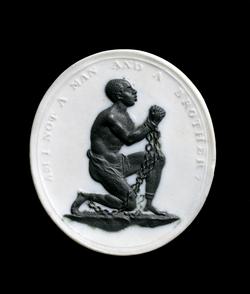Current Location: Exhibition: Rise Up: Resistance, Revolution (20th Century Gallery): case
Titles
Emancipation Badge
Maker(s)
Factory:
Wedgwood, Josiah
Designer:
Webber, Henry
Modeler:
Hackwood, William
Entities
Categories
Description
Jasper, white with black relief. Circular with depiction of an enslaved African man, shackled, kneeling, in profile to the right. Round the edge, the inscription, 'AM I NOT A MAN AND A BROTHER?'.
Notes
History note: Unknown before donor
Legal notes
Given by Mrs G. E. Moore
Measurements and weight
Height: 3 cm
Width: 2.8 cm
Acquisition and important dates
Method of acquisition: Given
(1962-11-29)
by
Moore, G. E., Mrs
Dating
George III
Production date:
circa
AD 1787
Note
Although this image proved effective at the time, some reformers advocated instead for images that focussed on the strength and dignity of those of African descent, instead of portraying them as powerless.
For more information on Wedgwood and Franklin’s correspondence, see Finer and Savage, ‘Selected Letters of Josiah Wedgwood’, p. 311-2. Franklin replied on 5 May 1788, (Yale University Library), see Elizabeth Bryden Adams, ‘The Dwight and Lucille Beeson Wedgwood Collection in the Birmingham Museum of Art’, Birmingham Alabama, 1992, p. 106, where quoted, and p. 174, note 79.
Slavery was abolished in England in 1833 but as it was not formally abolished in the whole of North America until 1865, many English slave owners continued to increase their wealth by selling enslaved people to American traders. Much of the wealth associated with the industrial revolution was directly connected to the trade and labour of enslaved people.
The medallions, made in Wedgwood’s famous jasperware (imitating ancient cameos), were incorporated into jewellery, shoe buckles, hairpins and campaign buttons, allowing supporters of the abolitionist movement to publicly demonstrate their support for the cause and help to spread word of the Society and its aims. The image, together with the accompanying phrase, ‘Am I not a man and a brother?’ became one of the most powerful symbols of the abolitionist cause and it was widely copied and adapted. It can be found painted on ceramic patch boxes, cast in metal medals and even woven and beaded in textile form. Wedgwood distributed these medallions widely, sending 500 to founding member of the Society, Thomas Clarkson, and 400 to Benjamin Franklin in Philadelphia. Franklin gave them to his friends and thanked Wedgwood, writing, ‘I am persuaded it may have an effect equal to that of the best written pamphlet in procuring honour to those oppressed people’.
This badge was used to advocate for the abolition (end of) the trade in enslaved African people. It was produced for the Society for the Abolition of the Slave Trade, formed in 1787, which campaigned vigorously in favour of a new law through the production of widely-distributed pamphlets, books, posters and prints. Famous ceramic manufacturer Josiah Wedgwood had long been a staunch abolitionist and after joining the Society, his factory began to produce medallions depicting this image, which is attributed to sculptor Henry Webber and prepared for production by modeller William Hackwood.
People, subjects and objects depicted
Components of the work
Relief
Materials used in production
white and black
Jasper ware
Inscription or legends present
- Text: AM I NOT A MAN AND A BROTHER?
- Location: Round the edge
- Type: Legend
References and bibliographic entries
-
From Reason to Revolution, Art and Society in Eighteenth-Century Britain
-
Feast & Fast. The Art of Food in Europe 1500-1800
page(s): 91
-
The Dwight and Lucille Beeson Wedgwood Collection at the Birmingham Museum of Art
page(s): 106, 174
-
Good European Ceramics, Glass and Enamels
-
Victoria and Albert Museum Department of Ceramics, Catalogue of English Porcelain, Earthenware, Enamels and Glass collected by Charles Schreiber Esq., M.P., and the Lady Charlotte Elizabeth Schreiber, and presented to the Museum in 1884, Volume I, Porcelain
page(s): p. 105
-
18th Century Wedgwood, A Guide for Collectors & Connoisseurs
page(s): 151
-
Masterpieces of Wedgwood in the British Museum
page(s): 45
-
Wedgwood in London, 225th Anniversary Exhibition 1759-1984
page(s): 36
-
Important English Furniture, Ceramics and Decorations, 21st October 1999
page(s): pp. 42-3
-
The Collections of Hanns and Elisabeth Weinberg and the Antique Company of New York, Important European Ceramics and Objects of Vertu
page(s): 54
-
British and European Ceramics and Glass
Related exhibitions
Identification numbers
Accession number: C.45-1962
Primary reference Number: 11477
Stable URI
Audit data
Created: Saturday 6 August 2011
Updated: Thursday 13 February 2025
Last processed: Tuesday 22 July 2025
Associated departments & institutions
Owner or interested party:
The Fitzwilliam Museum
Associated department:
Applied Arts

 IIIF Manifest
IIIF Manifest




